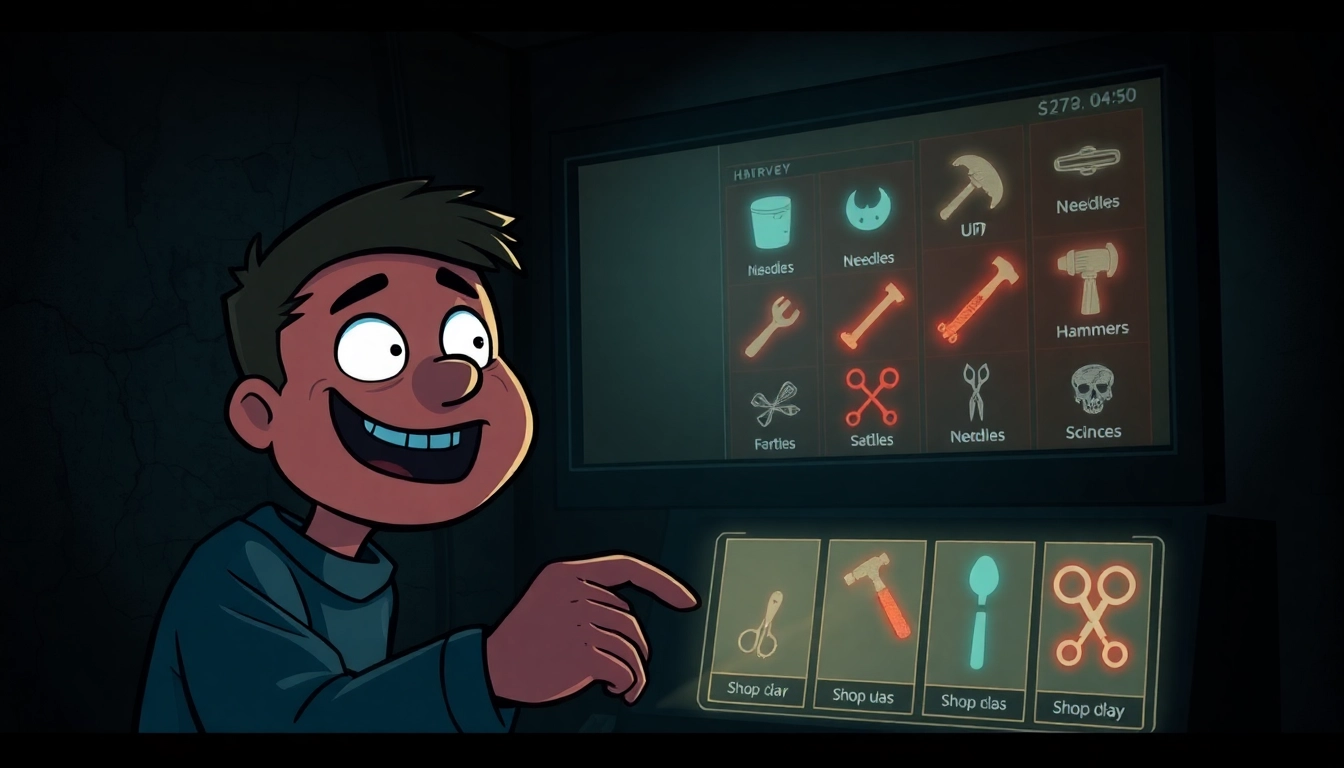
Overview and Context: The Dark World of BLOODMONEY
In the landscape of psychological horror games, few titles venture as deeply into the murky waters of morality and human nature as bloodmoney harvey. This unsettling clicker game combines minimalist gameplay mechanics with a haunting narrative, challenging players to confront their own ethical boundaries amid a desperate fight for survival. At its core, BLOODMONEY immerses players in a disturbing moral dilemma: how far are you willing to go to secure the financial means for life-saving treatment? With each click, you generate money—but at what cost? The game’s premise hinges on a simple yet profoundly impactful mechanic: clicking on a cheerful character named Harvey to earn money, which slowly spirals into a moral descent as Harvey’s suffering intensifies. This unique combination of gameplay and storytelling makes BLOODMONEY a compelling exploration of human morality under duress.
The Gameplay Mechanics: Clicking, Upgrades, and Moral Choices
Core Gameplay: The Clicker Dynamic
At its foundation, BLOODMONEY is a clicker game where players repeatedly click on Harvey, a cheerful, seemingly innocent character. Each click nets the player a dollar, bringing them closer to their urgent goal of raising $25,000 to pay medical bills. This mechanic is straightforward, but the game’s genius lies in its psychological impact. The more you click, the more Harvey appears to suffer; his visual state deteriorates, and his reactions become increasingly distressed. This creates a visceral tension—every click feels both productive and morally reprehensible.
Upgrade System: Tools of Profit and Pain
As players progress, they unlock an in-game shop where they can purchase upgrades to increase earnings. These upgrades range from benign tools like pillows for “pillow fights” to more violent implements such as needles, scissors, or hammers. Each purchase amplifies Harvey’s pain and suffering, but also significantly boosts income per click. The game offers a twisted risk-reward dynamic: the more violent the tool, the faster the financial goal can be achieved, but at a steep moral and visual cost. The upgrade system embodies the game’s central dilemma—pursuing profit at the expense of Harvey’s well-being.
Multiple Pathways: Choosing Your Moral Path
Players are presented with multiple pathways through the game, each reflecting different moral choices. Opting for minimal harm involves avoiding the most violent tools, resulting in a longer, more morally upright journey towards the goal. Conversely, maximizing profit might mean purchasing the most brutal upgrades, such as hammers or needles, which accelerate earnings but cause Harvey extreme suffering. This branching path system ensures that each playthrough is unique and that the player’s moral stance is directly reflected in the ending they receive.
The Dark Narrative of BLOODMONEY and Harvey
Harvey: The Innocent Face of Horror
Harvey is initially presented as a cheerful, friendly character—an embodiment of innocence and hope. His bright demeanor and naive surprise at the shop’s offerings evoke a sense of misplaced trust. However, as the game progresses and the violence of the upgrades escalates, his reactions change. His facial expressions and dialogue subtly shift from cheerful to distressed and fearful, reflecting the mounting suffering. Interestingly, players have observed that Harvey seems genuinely surprised by some of the more violent tools, which implies that he may not fully comprehend what’s being done to him. This adds a layer of tragic innocence to his character and intensifies the moral complexity of the game.
The Evolution of Visual and Psychological Cues
The game masterfully employs visual cues—Harvey’s changing facial expressions, body language, and the horrifying visuals of his wounds—to evoke empathy and discomfort simultaneously. Dialogue and subtle sound cues further heighten the unsettling atmosphere. As Harvey’s suffering increases, players may feel a growing sense of guilt, prompting reflection on the nature of morality and the human capacity for cruelty when pushed to the brink.
The Psychological Horror and Time Pressure
Building Tension with Time and Urgency
The ticking clock is a central mechanic that heightens the game’s psychological tension. Players are under immense pressure to reach the $25,000 goal quickly, as delay means worsening Harvey’s condition and increasing visual horror. This time constraint not only amplifies the sense of desperation but also forces players into making rapid moral decisions, often without fully considering the consequences. The game’s pacing mimics real-life scenarios of urgent medical needs, where delay can be fatal, thus reinforcing the moral dilemma’s gravity.
Visual and Audio Cues that Heighten Unease
From the moment you start clicking, BLOODMONEY immerses players in an increasingly disturbing environment. Visual cues such as Harvey’s swelling wounds, bloodstains, and fearful expressions become more pronounced with each upgrade. The audio design complements these visuals—distorted, unsettling sound effects and subtle ambient noises create an oppressive atmosphere. These elements work together to evoke visceral discomfort, making each decision feel weighty and morally charged.
Multiple Endings: The Outcomes of Your Choices
Three Distinct Endings Based on Player Morality
The culmination of your choices in BLOODMONEY results in one of three endings, each offering a different perspective on morality and human nature:
- The Good Ending: Achieved by minimizing Harvey’s suffering, avoiding violent upgrades, and focusing on ethical choices. This ending portrays a narrative where compassion prevails, and the protagonist’s moral integrity remains intact.
- The Normal Ending: A middle ground where some violence is accepted to reach the goal, reflecting a compromise between survival and morality. Harvey endures moderate suffering, and the ending leaves some moral ambiguity.
- The Bad Ending: The path of maximum profit at any cost, including the most violent upgrades. Harvey’s suffering is extreme, and the ending reveals a descent into moral darkness, often accompanied by disturbing visuals and dialogue.
The game subtly tracks player behavior, and multiple playthroughs reveal that even with seemingly immoral choices, achieving the Good Ending is possible through specific strategies, adding depth to the moral exploration.
Community Insights and Player Reactions
Player Reflections: Morality, Empathy, and Horror
The BLOODMONEY community is vibrant and deeply engaged. Many players report feelings of guilt and emotional distress while playing, highlighting the game’s effectiveness at simulating moral dilemmas. Some note that Harvey’s reactions and the visual cues evoke genuine empathy, despite the game’s brutal premise. Others find the game’s commentary on human nature compelling—questioning whether we’re inherently good or evil when faced with desperation. The game’s community often discusses the subtle details, such as Harvey’s surprise at violent tools, which suggest he may be unaware of the true extent of his suffering. This ambiguity invites ongoing debate about innocence, complicity, and morality.
Reactions to Visual and Narrative Elements
Many players commend the game’s ability to create an unsettling atmosphere without relying on traditional horror tropes. Instead, it uses psychological cues and emotional storytelling to craft a disturbing experience. The evolving visuals, dialogue, and Harvey’s changing demeanor serve as powerful tools that make each decision feel impactful, often leading to intense emotional reactions. The community has also produced numerous gameplay videos and analyses, deepening the understanding of the game’s layered narrative and mechanics.
The Game’s Commentary on Human Nature and Morality
BLOODMONEY functions as a dark mirror reflecting human tendencies toward self-preservation and moral compromise. It questions whether the desire to survive justifies unethical actions. Harvey symbolizes innocence and hope, yet the game exposes how easily innocence can be corrupted when survival is at stake. The escalating violence of upgrades mirrors real-world scenarios where desperation can push individuals toward morally questionable decisions. Ultimately, BLOODMONEY challenges players to consider how they define morality and whether compassion or profit should take precedence when lives hang in the balance.
Comparing BLOODMONEY to Other Dark Psychological Games
While many psychological horror games explore themes of fear, trauma, and madness, BLOODMONEY distinguishes itself through its minimalist clicker mechanics combined with deeply moral storytelling. Unlike traditional horror titles that rely on jump scares or overt gore, BLOODMONEY’s horror is psychological—built through visuals, dialogue, and moral tension. Its focus on player choice and consequence aligns it with narrative-driven titles like *The Stanley Parable* or *Papers, Please*, but with a much darker, visceral undertone. The game’s ability to evoke empathy and guilt in such a simple framework makes it a unique entry in the genre of dark psychological experiences.
Final Thoughts: Moral Boundaries Tested by Desperation
At its heart, BLOODMONEY is more than just a disturbing game; it’s a reflection of the human condition under extreme stress. The game masterfully forces players to confront their own morality, testing how far they are willing to go when their life depends on it. Will you choose the path of compassion, minimizing Harvey’s suffering? Or will you prioritize efficiency and profit, regardless of the human cost? The game’s multiple endings serve as a mirror to our moral choices, making each playthrough a deeply personal exploration of ethics, empathy, and darkness.
In conclusion, BLOODMONEY exemplifies how simple gameplay mechanics can be harnessed to tell a profound and unsettling story about human nature. It challenges players to question their morals, reflect on their empathy, and confront the uncomfortable truths about survival and self-interest. For those willing to look beneath its sinister surface, BLOODMONEY offers a harrowing but illuminating experience—one that lingers long after the screen goes dark. If you’re intrigued by psychological horror that probes the depths of morality, this game is an unmissable journey into the darkest corners of the human psyche. Discover more about this disturbing experience and explore its layered narrative by visiting the official site, and remember: how far are you willing to go when your life is at stake?
To delve deeper into the unsettling world of bloodmoney is to confront the uncomfortable truths about ourselves. The game’s dark, morally ambiguous universe continues to captivate and disturb players worldwide, prompting ongoing debate about morality, empathy, and the human capacity for cruelty. Whether you aim for the moral high ground or succumb to the darker impulses of profit, BLOODMONEY remains a haunting reflection of our own morality in the face of despair.




